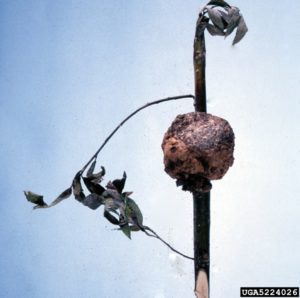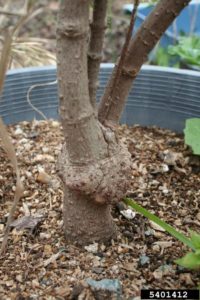
Photo credit: Florida Division of Plant Industry , Florida Department of Agriculture and Consumer Services, Bugwood.org
COMMON NAME: Crown Gall
SCIENTIFIC NAME: Rhizobium radiobacter (previously known as Agrobacterium tumefaciens)
DISEASE DESCRIPTION
SYMPTOMS:
Rhizobium radiobacter is a bacterial plant pathogen that induces tumorous growths of various sizes and shapes on infected trees. In severely infected trees the disease can cause stunting, chlorosis, and shoot dieback. Crown gall can ultimately cause trees to die by girdling the stem and thus inhibiting water or nutrient transport. Wounded young trees are much more susceptible to the pathogen, which is the reason the disease is often considered a nursery problem since older trees do not die but rather survive in a weakened condition.

Photo credit: Lesley Ingram, Bugwood.org
Tumors or galls are usually found on graft unions, bud unions, roots, stems, and crowns at or below the soil surface. However, the bacteria can move up internally through the tree’s vascular system into its branches and develop galls above ground sometimes 40 feet or higher in the tree. Galls can vary in size from small tissues connected to the host surface to massive structures. New galls often appear as flesh-colored callouses that are soft and spongy whereas older tumors frequently have odd-shaped swellings that are rough, woody, or corky and appear knot-like. As galls age, the surface may decay and crack or slough off the tree. However, galls can develop new tissue and reappear repeatedly in the same area. Secondary tumors may also develop near the inoculation site.
BIOLOGY:
Rhizobium radiobacter carries tumor-inducing genes that genetically modify its host to produce auxin and cytokinin hormones that promote cell division. Soon after the infection, the infected plant cells begin to divide and expand uncontrollably causing a gall or tumor to grow. The tumors then produce a rare amino acid that the pathogen can use as food. Because the pathogen alters the DNA of the tree to redirect metabolic activities toward producing nutrients that only the pathogen can use, the bacterium has an abundant and continuous source of food. The pathogen is attracted to a chemical substance released by newly wounded plant tissue below the soil or at the soil line. The plant’s wounds could be caused by grafting, environmental damage, insects, pruning, or any other type of physical damage. The bacteria enter the plant’s roots or stems through the wounds and can produce galls at the plant’s crown, which could cause girdling, or it can move up the tree and into its branches through the tree’s vascular system and produce galls high in the tree. With age, the gall decays and sloughs off the tree on the ground and the bacteria returns to the soil where it can be spread by water or farm equipment. It can colonize and live in the soil for several years. The bacteria may also be spread by using contaminated pruning tools or through contaminated water splashed onto fresh pruning cuts.
MANAGEMENT METHODS:
Established trees and shrubs generally can tolerate crown gall and can be left in the landscape. If a tree’s stem is girdled or when a young tree shows signs of symptoms the trees must be removed and destroyed including all infected debris. There is no chemical that can be applied to kill the pathogen. However, good sanitation and cultural practices will help prevent the disease.
- Inspect nursery stock for crown gall symptoms before planting and reject infected trees. Purchase budded trees instead of grafted trees.
- Plant only certified crown gall-free willow trees.
- All practices that wound tissue such as pruning should be avoided and chewing insects should be controlled.
- Soils known to be infested with the pathogen should be planted with nonsusceptible plants for several years before planting willow trees.
- Biological control agents are effective using the antagonistic bacterium Agrobacterium radiobacter strain K-84 or K-1026. Dip the rootstock or soak seeds in the antagonistic bacterium which will inhibit the colonization of the roots by the crown gall pathogen.
- Sterilize pruning tools by dipping them in rubbing alcohol for a minute or longer.
RESOURCE LINKS:
- Texas A&M AgriLife Extension’s Texas Plant Disease Handbook – https://plantdiseasehandbook.tamu.edu/landscaping/trees/willow/
- Texas A&M AgriLife Extension’s Texas Plant Disease Handbook – https://plantdiseasehandbook.tamu.edu/problems-treatments/problems-affecting-mhttps://web.extension.illinois.edu/hortanswers/detailProblem.cfm?PathogenID=23 ultiple-crops/crown-gall/
- Fact sheet written by John Bonkowski, Bacheline Joseph, Deanna Bayo from the University of Florida published on Bugwood website – https://wiki.bugwood.org/Agrobacterium_tumefaciens
- University of California Agriculture and Natural Resources Statewide Integrated Pest Management Program website – How to Manage Pests page http://ipm.ucanr.edu/PMG/GARDEN/PLANTS/DISEASES/crowngall.html
- University of Minnesota Extension website – plant disease page – https://extension.umn.edu/plant-diseases/crown-gall
- Agrios, G. (2005) Plant Pathology. 5th Edition, Elsevier Academic Press, Amsterdam, 26-27,398-401.
This factsheet is authored by
Jaimi Washburn
pursuing a Masters in Ag. with a focus on Ornamental Horticulture
Factsheet information for the plant health issues represented by the images on the 2020 TPDDL calendar were written by graduate students enrolled in the Department of Plant Pathology & Microbiology DR. DAVID APPEL’s Graduate level Introductory Plant Pathology course (PLPA601) in the 2019 Fall semester. This exercise provides an opportunity for a high impact learning activity where the students are tasked with producing an informational output directed to the general public. This activity provides an opportunity for the students to write and produce a (hopefully) useful product to communicate information on plant health issues to the public.